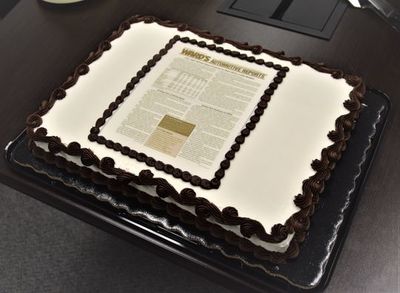Ward's Automotive Reports Stops Print Edition
On the chance you may not have heard, the iconic automotive industry newsletter, "Ward's Automotive Reports" has ended its almost 100-year presence tracking the motor vehicle world.
Even if you never needed to refer to it directly, you've likely heard or read Ward's Automotive Reports cited in other automotive news articles.
The Ward's name and role in the automotive information specialty may continue in new variations of the brand's equities, yet we'll miss the print newsletter.
Reading this feels a little bit like the earlier experience of saying good-bye to respected brands like Plymouth, Pontiac and Oldsmobile. Times change and the digital age of media and communications is certainly transformational.
One thing about the world of wheels that's both exciting and challenging is it has always been dynamic. Make room for the new models also applies to publications.
I still have saved one "token" 8-track cassette tape around somewhere -- no doubt easier to spot than if I drop the 64-gigabyte micro SD card from my Sony camera on the floor!
Best of momentum to you,
Steve Ford, The Car Guy
Ward's Automotive Reports Stops Print Edition
One of the auto industry’s longest-running institutions just ended. Ward's Automotive Reports, the 96-year-old weekly newsletter that helped create the craft of automotive journalism, published its last issue Jan. 28, after breaking news since 1924.
Shorthanded WAR by the abbreviation-crazed auto industry, the newsletter got its start publishing production figures for the vehicle plants scattered across Detroit in the booming 1920s.
Initially named Cram’s Reports for its founder’s last name, the newsletter fed investors' appetite for information on the hot new industry. Cram’s president Al Ward assigned reporters and editors to hang out by the factory gates, asking workers how many Model Ts, etc. they built each day.
Automakers eventually realized it was in their interest to report official production figures, and WAR’s decades-long run as the self-described “Bible of the auto industry” began.
“Al Ward was the genius behind it all,” said David C. Smith, retired Ward's editorial director. “He hired reporters who’d go out to get the news, not just wait around for what the companies wanted to tell them.” Ward later bought the company and changed the newsletter’s name.
Innovations
WAR was noteworthy for many things, including:
· Colored paper. Originally yellow, later brown, the paper was a holdover from the early 20th century when it was difficult to copy colored pages.
· Pages of data on everything from production of various body styles to trends in engine and transmission technology.
· Short, dense text blocks that packed lots of information into a small space.
· An insistence that everything be written in the present tense, to make the news seem immediate.
WAR became the primary source for all manner of news and data from the plants, suppliers and engineering centers. It spun off several other publications under the Wards Auto umbrella, which today includes conferences and research reports. (And, for the eagle-eyed reader, the organization no longer uses the apostrophe used in the newsletter name.)
WAR published data suppliers used to plan their own production. Dealers studied the figures to see what was selling, how the competition was doing and whether the factory was about to shove extra trainloads of a slow-selling car down their throats.
A year’s subscription to WAR cost $50 when Ward's hired Smith away from his job as Free Press business and auto editor in 1970. It was about $2,000 when publication ceased this week.
WAR’s circulation was one of the auto industry’s most closely guarded secrets, but for decades, you could find each week’s edition in the anteroom to every senior executive’s office.
“It brings a small tear to my eye,” Smith said. “WAR broke a lot of news because it had data and statistical expertise nobody else had back then.”
Sweating every detail
My first job in automotive journalism was at Wards. Not at WAR, but reporting and editing publications focused on technology, engineering and strategy. The WAR team was something to behold, agonizing to the last decimal point, turning reams of faxed production figures into data that defined the auto industry and pounding the keys of mechanical adding machines.
People stayed at WAR for decades, including a managing editor who wore an honest-to-God green eyeshade that looked like it belonged on a 1920s banker.
WAR’s name is the only thing that’s disappearing. Wards will continue to offer online subscribers the data they got in WAR, and more. The people who contributed to WAR will keep their jobs, feeding information to Wards' other publications and products. WAR switched from hard copy to PDF a couple of years ago. Now all the information is migrating toWardsintelligence.com.
“Al the news, analysis and data will be available online,” Wards Intelligence managing director John Sousanis said.
“WAR established Wards expertise in the market for decades. That DNA is still in all our information. Our mission is to provide data about the auto industry to the auto industry.”



